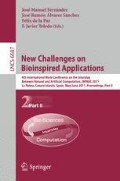Abstract
Knowing the strain response of materials in strength tests is one of the main issues in construction and engineering fields. In these tests, information about displacements and strains is usually carried out using physical devices attached to the material.
In this paper, the suitability of Computer Vision techniques to analyse strength tests without interfering with the assay is discussed and a new technique is proposed.
This technique measures displacements and deformations from a video sequence of the assay.
With this purpose a Block-Matching Optical Flow algorithm is integrated with a calibration process to extract the vectorfield from the displacement in the material.
To evaluate the proposed technique, a synthetic image set and a real sequence from a strength tests were analysed.
Access this chapter
Tax calculation will be finalised at checkout
Purchases are for personal use only
Preview
Unable to display preview. Download preview PDF.
References
Abad, F.H., Abad, V.H., Andreu, J.F., Vives, M.O.: Application of Projective Geometry to Synthetic Cameras. In: XIV International Conference of Graphic Engineering (2002)
Amiaz, T., Lubetzky, E., Kiryati, N.: Coarse to over-fine optical flow estimation. Pattern Recognition 40(9), 1503–2494 (2007)
Austvoll, I.: A Study of the Yosemite Sequence Used as a Test Sequence for Estimation of Optical Flow. In: Kalviainen, H., Parkkinen, J., Kaarna, A. (eds.) SCIA 2005. LNCS, vol. 3540, pp. 659–668. Springer, Heidelberg (2005)
Chin, R.T., Harlow, C.A.: Automated visual ispection. IEEE Transactios on Pattern Analysis ad Machine Intelligence 4(6) (1982)
Chivers, K., Clocksin, W.: Inspection of Surface Strain in Materials Using Optical Flow. In: British Machine Vision Conference 2000, pp. 392–401 (2000)
Deng, Z., Richmond, M.C., Guensch, G.R., Mueller, R.P.: Study of Fish Response Using Particle Image Velocimetry and High-Speed, High-Resolution Imaging. Technical Report. PNNL-14819 (2004)
Graphics and Vision Research Laboratory, Department of Computer Science, University of Otago, http://www.cs.otago.ac.nz (accessed November 2010)
Heeger, D.: Model for the extraction of image flow. Journal of the Optical Society of America A: Optics, Image Science, and Vision 4, 1455–1471 (1987)
Horn, B.K.P., Schunk, B.G.: Determining Optical Flow. Artificial Intelligence 17, 185–203 (1981)
Kadem, L.: Particle Image Velocimetry for Fluid Dynamics Measurements. Applied Cardiovascular Fluid Dynamics (Concordia University), Particle Image Velocimetry (2008)
Malsch, U., Thieke, C., Huber, P.E., Bendl, R.: An enhanced block matching algorithm for fast elastic registration in adaptive radiotherapy. Phys. Med. Biol. 51, 4789–4806 (2006)
Manchado, A.R.: Calibracion de camaras no metricas por el metodo de las lineas rectas. Mapping 51, 74–80 (1999)
Martin, N., Perez, B.A., Aguilera, D.G., Lahoz, J.G.: Applied Analysis of Camera Calibration Methods for Photometric Uses. In: VII National Conference of Topography and Cartography (2004)
McCane, B., Novins, K., Crannitch, D., Galvin, B.: On Benchmarking Optical Flow. Computer Vision and Image Understanding 84, 126–143 (2001)
Open Source Computer Vision, http://opencv.willowgarage.com (accessed November 2010)
Particle image Velocimetry, http://www.piv.de (accessed November 2010)
Raffel, M., Willert, C., Kompenhans, J.: Particle Image Velocimetry, a Practical Guide. Springer, Berlin (2000)
Raffel, M., Willert, C., Kompenhans, J.: Particle Image Velocimetry, a Practical Guide, 2nd edn. Springer, Berlin (2007)
Scharstein, D., Baker, S., Lewis, J.P.: A database and evaluation methodology for Optical Flow. In: ICCV (2007)
Schwarz, D., Kasparek, T.: Multilevel Block Matching technique with the use of Generalized Partial Interpolation for Nonlinear Intersubject Registration of MRI Brain Images. European Journal for Biomedical Informatics 1, 90–97 (2006)
Author information
Authors and Affiliations
Editor information
Editors and Affiliations
Rights and permissions
Copyright information
© 2011 Springer-Verlag Berlin Heidelberg
About this paper
Cite this paper
Rodriguez, A., Rabuñal, J.R., Perez, J.L., Martinez-Abella, F. (2011). Study of Strength Tests with Computer Vision Techniques. In: Ferrández, J.M., Álvarez Sánchez, J.R., de la Paz, F., Toledo, F.J. (eds) New Challenges on Bioinspired Applications. IWINAC 2011. Lecture Notes in Computer Science, vol 6687. Springer, Berlin, Heidelberg. https://doi.org/10.1007/978-3-642-21326-7_28
Download citation
DOI: https://doi.org/10.1007/978-3-642-21326-7_28
Publisher Name: Springer, Berlin, Heidelberg
Print ISBN: 978-3-642-21325-0
Online ISBN: 978-3-642-21326-7
eBook Packages: Computer ScienceComputer Science (R0)

